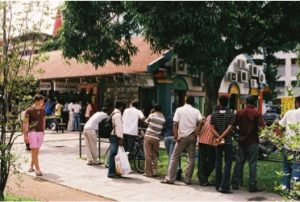Memo #260
By Wajihah Hamid – wajihah.hamid [at] gmail.com
 Riot, angry mob? Surely unheard of in Singapore? But on Sunday, December 8, 2013, a fatal traffic accident involving a migrant worker in Singapore’s Little India sparked an angry reaction from the area’s low-waged migrant workers that morphed into a riot.
Riot, angry mob? Surely unheard of in Singapore? But on Sunday, December 8, 2013, a fatal traffic accident involving a migrant worker in Singapore’s Little India sparked an angry reaction from the area’s low-waged migrant workers that morphed into a riot.
Temporary labour migration is the most prevalent form of migration in Asia. With a small resident labour force, Singapore’s dependence on foreign low-skilled labour grew from 120,000 workers in 1980 to 1.1 million in 2013. Of these, there are an estimated 300,000 men from India and Bangladesh, categorised as ‘low-skilled’ and working largely in the construction industry. They gather in Little India on Sundays to meet friends from their village, remit money, worship and shop for groceries.
Tamils from India comprise one of the largest groups of construction workers in Singapore. The traffic accident victim was a Tamil as were most of the men involved in the riot. Though they have been labouring in Singapore for three decades, because they are classified as temporary residents their existence has been ignored, or worse, their presence has been represented as a social problem.
Though the migrant worker’s stay in a country may be temporary, the phenomenon of labour migration itself is here to stay. Amnesty International’s recent report on the conditions of construction workers in Qatar underlines the vulnerability of migrant men to mistreatment and exploitation. Some have experienced psychological distress due to abuse and the accompanying sense of helplessness. Examining how such migratory experiences challenge the masculinity of these men should be part of any attempt to develop more effective ways of managing migrant workers and of providing pre-departure training to them.
The reduction of migrant workers has been advanced as an option in Singapore but this does not eliminate issues such as differential wages and non-payment of wages facing some of them. Driven by various residential and commercial demands, the construction sector continues to boom. Shunned by Singaporeans, these jobs traditionally have been considered to be dirty, dangerous and difficult. Incidents such as the recent riot should be used as a starting point for a re-examination of the management of low-skilled migrant labour that goes beyond just the economic dimension to consider the social and psychological realities faced by such workers.
About the Author:
Wajihah Hamid graduated with an MA in Migration Studies from the University of Sussex. She currently works as a research assistant with the Asia Research Institute at the National University of Singapore.

Migrant labourers spending their leisure time in the Little India neighbourhood of Singapore (image source: Wajihah Hamid, 2012).
Links:
- “Riot in Little India after Bus Knocks Down Pedestrian,” Transient Workers Count Too, December 2013
- “’Premature’ to pin Little India riot on labour tensions, Singapore minister says,” South China Morning Post, December 2013
- “Qatar: The Dark Side of Migration,” Amnesty International Report, November 2013
- Governing Labour Migration: Current Issues, Challenges and Dilemmas, edited by C. Gabriel and H. Pellerin (2008)
Related Memos:
See our other memos on Singapore.

[…] migrant labor to ensure continuous development, but it is imperative that concerns such as the psychosocial wellbeing of workers are factored into policymaking from both sending and receiving […]